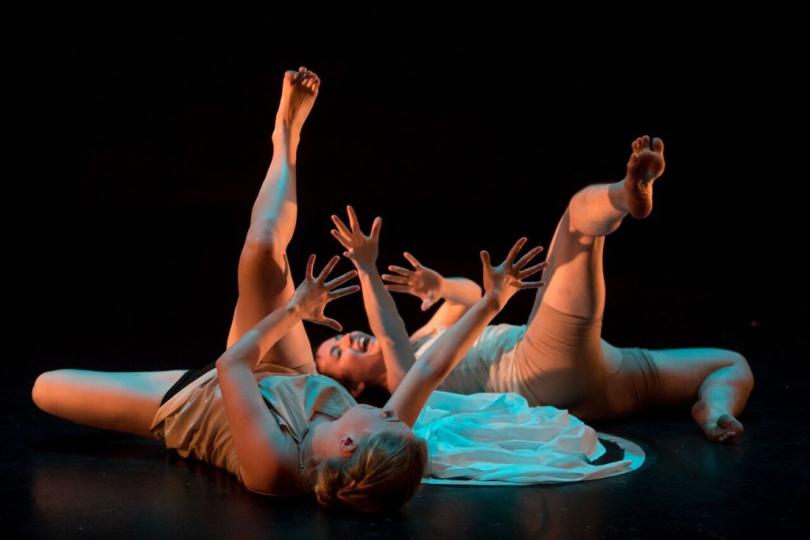Twin Cities Horror Festival comes into its own

It seems to me that this is the year when the Twin Cities Horror Festival turns the corner from “cool cult event” to “local institution.” There’s been more media coverage than in previous years, the lineup offers an impressive mix of newcomers and returning veterans, and the shows have been well-attended and enthusiastically received. As a writer who’s been enamored of TCHF since I went in blind to Dangerous Productions’ debut gore extravaganza Senseless back in 2012, I’m delighted to see the festival continuing to grow and challenge itself and its audience. Here’s what I’ve taken away from the first weekend of performances. As usual, my biggest regret is that I can’t make the time to see every show.
The tamer side
Even though TCHF is a horror festival through and through, one of its welcome facets is that there’s always a strong selection of less horrific horror for those with weaker stomachs.
Book of Shadows II
Erin Sheppard Presents would be the local standard bearer for horror-themed dance even if that were a more hotly contested title. Every year the company pulls together an engaging collection of thematically linked narrative dance pieces interwoven with storytelling, a fascinating hybrid that never lacks for energy.
This year the performances are built around a Heather Meyer short story of an aspiring young witch taking spiteful revenge on the coven that once rejected her, with a running theme of supernatural manipulation twining throughout the dance numbers. One of the eternally impressive aspects of an ESP show is watching the ways the dancers convey the horror of their situations even while their physical movements remain upbeat and exuberant—watch Jessica Chad’s face gradually melt into dismay as her “Red Shoes”-inspired hip-hop dance routine pushes a hapless dancer past her limits. Scored with an impeccable, eclectic soundtrack ranging from Eels to Jay-Z to Squirrel Nut Zippers, this is another killer entry from what’s possibly TCHF’s most consistently excellent production company.
Between the Devil and the Deep Blue Sea
As much as I lament not being able to see every TCHF show every year, that also means that every installation includes new gems for me to unearth. Case in point: I’ve never caught one of Reverend Matt’s much-loved monster lectures until this year. Having now seen Matt Kessen speak at length about the history of The Devil, I understand the appeal.
Kessen’s format is as simple as it is infallible: a professorial lecture about the history and cultural significance of a given monster or group of monsters, with a deftly curated slideshow for illustration. Kessen’s monologue is genuinely informative—I came away knowing a whole lot more about the many incarnations of Satan through the ages than I did going in—and also plenty funny—his points are just as likely to be illustrated by an image of Ned Flanders or Jon Lovitz as the devil as they are by a gruesome lithograph from Dante’s Inferno. The production works so well because it’s clear that Kessen cares equally about both sides of the equation. He’s here to get laughs, certainly, but the care and thoroughness of his research makes it evident that educating the masses is also a vital part of his mission.
The Legend of Sleepy Hollow
My worry going into any show specifically billed as all-ages, particularly an adaptation of a well-known classic, is that the script is going to condescend to its young audience in the interests of keeping it “kid-friendly.” Fortunately, Rogues Gallery Art’s take on The Legend of Sleepy Hollow is the sort of adaptation that understands that any kid who’s likely to be in the audience to see a Washington Irving story at a horror theater festival is the type of kid who doesn’t need to be talked down to.
As a matter of fact, the kid-catering touches in this production elevate the experience for all ages. The relative slightness of Irving’s original story — a milquetoast teacher (Andy Browers) squabbles with a romantic rival (Mahmoud Hakima) before possibly encountering a locally infamous headless specter — allows writers Duck Washington and Tim Wick to make welcome punch-ups like expository folk songs, some comic-relief Greek chorusing from Geoffrey Brown and an especially delightful Erin Kennedy, and one of the more wonderfully unreasonable facsimile of a horse you’re likely to see on stage. While the show does get a little talky and inert in places, on the whole it’s a welcome rarity for the festival and local theater in general: a genuinely creepy horror play that the whole family can enjoy.
The harder stuff
Of course, family-unfriendly fare about unfriendly families is a staple of the horror genre, as evidenced by two stalwarts presenting work that ranks among the best shows TCHF has ever featured and a newcomer that pushes things in some intense new directions.
The Bathtub Girls
Perennial TCHF favorites The Coldharts take a detour from their much-loved oddball mini-musicals this year, instead producing a striking two-woman show by Toronto’s Kairos Collective. Based on a true story, The Bathtub Girls tracks the painful existence of two teen girls who have recently relocated from Eastern Europe to Canada, living under the unpredictable hand of their dangerously alcoholic mother.
Creator-performers Robin Luckwaldt Ross and Natalia Bushnik accomplish something truly remarkable here, a show that filters the lurid world of True Crime through undulating layers of storytelling and physical movement. While there are occasional interactions with voiced-over dialogue, for the most part this show is two women alone onstage, relating their haunting story while shifting in and out of accents and languages, sometimes intertwining both their sentences and their bodies and other times lurching off in wildly divergent directions. It’s a haunting piece of work driven by a pair of supremely capable performers, and it’s not like much else you’ll see in the Horror Festival or anywhere else.
Home
Dangerous Productions has earned a reputation as arguably the festival’s biggest annual must-see, due largely to the company’s unparalleled aptitude for stage gore. While there’s never been anything approaching a bad Dangerous production at TCHF, the visual aptitude of director Tyler Olsen-Highness and his team has occasionally been tempered by scripts that come off as either slightly over- or under-ambitious. With Garrett Vollmer’s Home, Dangerous has found its best marriage of narrative and gore to date.
Set in the type of small town where Walmart is the community’s main social hub, Home tracks the dysfunctional day-to-day of one working-class family on the verge of fraying apart. The mom (Laura “Baller” Mahler”) is worn out from working two-jobs, the step-dad (Jay Kistler) is out of a job and none too eager to find another, the daughter (Mackenzie Diggins) is dealing with a possible sexual predator at high school, and the son (Jacob Mack) has made an unwanted friend in the creepy, sword-loving kid up the street (Ian Ebner).
Vollmer’s script is laced with sharply observed dark humor and a realistic weirdness — witness Brant Miller’s disturbing turn as a family friend who delights in gaslighting his visibly unstable wife (Heather Jo Raiter) — that makes the show’s escalation into acts of brutality all the more effective. A uniformly strong cast, anchored by Mahler’s hugely relatable performance as the coarse but caring mother, raises the stakes by making us care about much more than who’s going to bleed next and how much. It’s a show that would be plenty engaging even without the gore, but when the gore does come it’s a thrilling reminder that nobody does this type of thing better, if at all.
Greenway
Horror fiction has always been fertile ground for exploring social and political themes, but striking the right balance can be tricky. I worried in the early moments of Tom Reed’s Greenway might be one of those pieces of social commentary that lays it on too thick. A late-night bicycle ride between co-workers quickly disintegrates into sexual harassment and male entitlement, with Michael Rogers’ coffee shop manager using every odious line in the MRA handbook to try to pester Emily Rose Duea’s barista into sex.
Thankfully, Greenway steers clear of getting bogged down by its own message as its horrors evolve and Duea finds herself alone in the dark, being hunted by a red-eyed figure on an equally speedy bike. The physical staging of the long, consistently tense bicycle chase is an ingenious piece of work, as both bikes are dollied back and forth across the stage in a believable simulation of pursuit. The technical design of the show is top-notch all around, with lights switching on and off at the least opportune moments and long stretches of dialogue-free menace scored by an upbeat early ‘00s pop playlist blaring from Duea’s cell phone. While the conclusion is perhaps a little abrupt, Greenway stands strong as both a thrilling piece of onstage physicality and a grim metaphor for the endless parade of predators women are forced to contend with every time they leave the house.




